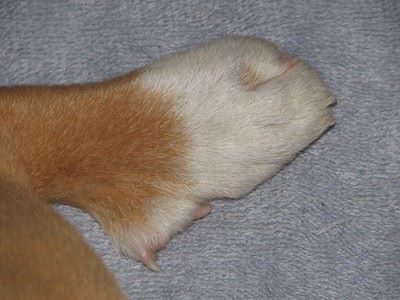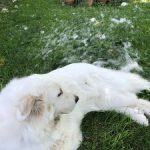
Some pet parents, especially those who have just got their first dog, are surprised to discover their furry friend has a weird claw-like thingy on their hind legs.
Is it normal?
What purpose does it serve?
Should they have it removed?
All these questions are perfectly normal as there aren’t that many dogs that have a double dewclaw, as this is how it’s called.
In this article we’ll have an in-depth look at what dewclaws and double dewclaws are, and we’ll also examine the pros and cons of having that extra digit removed.
What is a dewclaw?
When you look at your dog’s front paws you’ll notice that it has four toes that sit together at the front and a fifth one located further up the leg.
The first four are easy to understand as they visibly form the main part of a dog’s foot, but what’s the deal with the additional one?
The fifth leg is called a dewclaw and it’s main function is to stabilize the wrist.
Since it’s somewhat opposed to the other four, the dewclaw is often compared to a human thumb.
This description is not entirely correct as the dewclaw doesn’t have the same degree of functionality as a thumb, nor is it entirely wrong, as we’ll explain below.
If you want to understand the role of dewclaws, have a look at this video showing dogs running on icy terrain and ice fishing.
What is a double dewclaw?
While having a dewclaw on the front legs is normal for all dogs, those that also have dewclaws on the hind legs are rare.
The term double dewclaw refers to those extra digits on the hind legs.
Actually, they’re not exactly digits, they’re more of a genetic anomaly in most cases.
The dewclaw on the forelegs are fully-formed toes.
They have a bone structure and are connected by muscles and nerves to the dog’s leg.
On the other hand, the double dewclaws on the hind legs are in many cases nothing but a flap of skin with a little claw sticking out.
Since they have no connective muscular tissue they are quite useless.
Yet, a handful of breeds have fully-formed and functional double dewclaws.
In their case, it’s no longer considered a genetic anomaly.
The extra toe on the hind leg is in fact a breed standard.
What is the meaning of dewclaws?
You’d be tempted to think that the modern domestic dog inherited his dewclaws from its ancestor the wolf, but this is not the case.
Wolves do not have dewclaws on their front or hind legs.
The obvious conclusion is that dogs evolved and got dewclaws after befriending man.
Why did that happen is easy to see when it comes to the dewclaw on the forelegs.
Those serve a purpose, although a limited one.
Dogs use the dewclaw to get a better grip on objects, and it helps them with digging, climbing or navigating rough terrains.
If you watch your dog playing with his favorite chew toy or struggling with a huge juicy bone, you’ll see how it uses the dewclaws to grasp at the object and move it around.
Experts have discovered that some wolves present dewclaws, but they believe this only proves that at some point in their ancestry there was some genetic mixing when a wolf mated with a domesticated dog.
What dog breeds have double dewclaws?
Technically, any dog can be born with double dewclaws, but in such cases we are talking about an anomaly, a genetic throwback.
For a small number of large breeds, however, a double dewclaw is not only normal, but also a must according to AKC standards.
Double dewclaws are common among large working dog breeds, animals that for many centuries worked alongside their owners herding sheep.
In their case, the dewclaw on the hind legs is a fully-formed toe, complete with a bone structure and attached to the leg by nerves and muscles.
They used that extra digit to keep their balance on rough terrain, especially mountainous areas.
The list of breeds that have functional double dewclaws includes
- Great Pyrenees
- Anatolian Shepherd
- Briard
- Catalan Sheepdog
- Saint Bernard
- Norwegian Lundehund
- Beauceron
It is believed that these dogs were selectively bred to have this extra digit on the hind legs, as it made them better workers.
The toe that once gave them an edge is now viewed by dog owners as a useless appendage and they wonder what to do about it.
Should you remove double dewclaws?
The dewclaws on the forelegs serve a practical purpose, they help dogs keep their bearing while running and play with their toys, so there’s obviously no reason to have them removed.
Double dewclaws are a different matter.
Dog owners may choose to remove the double dewclaws purely for aesthetic reasons or to prevent injury.
If you’re planning to enter dog shows, removing the dewclaws on the hind legs might perhaps make the dog’s legs look better.
However, for breeds like Great Pyrenees, Beauceron and Briard, double dewclaws are considered breed standard and you won’t be allowed to enter any doggie beauty show.
This leaves us with potential dewclaw injury. Is the risk so great to warrant this type of surgery?
The idea is that the dewclaws on the hind legs could easily get caught in something causing the dog injury and infection.
Yet, the risks are low no matter what your vet or other dog owners might tell you.
In many cases, surgery to remove double declaws are scheduled the same time the puppy goes in for spaying or neutering.
Since the dog will receive anesthesia anyway, why not get rid of that useless little thing?
That sounds like a valid argument, but on the other hand why would you have the dog undergo an unnecessary medical procedure?
Some breeders go ahead and have the double dewclaws removed when the puppy is less than five days old.
Such surgery should only be performed by a vet using local anesthetic, although there are those who say small puppies won’t feel any pain. Really?
Is double dewclaw removal major surgery?
If by double dewclaw you understand a small flap of skin, probably not. However, for dogs with a fully-formed extra toe on the hind leg that’s major surgery.
Take, for instance, dogs like Great Pyrenees. The rear dewclaws present a bone structure, muscles and nerves. Removing the dewclaw implies bone cutting and severing nervous connections.
Done at an early age, the puppy will recover fast enough, but there’s no telling how the surgery will affect its future development.
Large breed dogs grow up slower than small ones. A Great Pyrenee or an Anatolian shepherd won’t reach maturity until they’re 18-24 months old.
Removing a toe that was meant to be there and offer support might cause future balance problems.
For dogs with functional double dewclaws, accidents involving the rear extra digit are uncommon. That toe is an integral part of the leg and a dog learns how to deal with it from an early age.
How to take care of dewclaws?
Just because they’re positioned a bit further from the rest, there’s no need to treat dewclaws differently than the other claws.
You should trim them at the same time, paying attention to the degree they appear to be worn down.
If the dewclaw doesn’t hit the ground with the rest of the toes, the nail will be longer so maybe you’ll need to trim it more often.
Rear dewclaws require special attention as there’s a greater risk of them curling and growing into the leg, which is very painful.
A weekly trim can take care of such problems, and it also gives you an opportunity to check for torn or split nails.
How to treat dewclaw injuries
Accidents involving dewclaws are not as common as some maintain, but they do happen.
If the dewclaw gets snagged on anything it might get torn. It’s not a serious injury, but there may be a lot of blood, enough to make you and the dog panic.
You need to clean the wound as best you can using warm water.
If the claw does appear torn, that requires a trip to the vet to have it surgically removed.
However, if the injury doesn’t seem all that serious, you can disinfect it using Betadine (not alcohol) and then you can apply an antiseptic ointment.
Monitor the injury for a couple of days. If you see any sign of infection, like redness, inflammation or puss take the dog to the vet.
Closing Thoughts
A dog with double dewclaws is a bit unusual, but this is nothing to worry about.
For some large breeds, double dewclaws are perfectly normal and their absence is seen as a flaw.
These dogs are born with fully-formed extra toes on the hind legs and they help them with balance. Many other dogs only have just a bit of skin with a claw attached to it on the rear legs.
It doesn’t serve any purpose, but that’s no reason to have it removed.
The risk of injury is pretty small and it’s something that makes your pet unique.
If it doesn’t bother the dog, why would it bother you?





